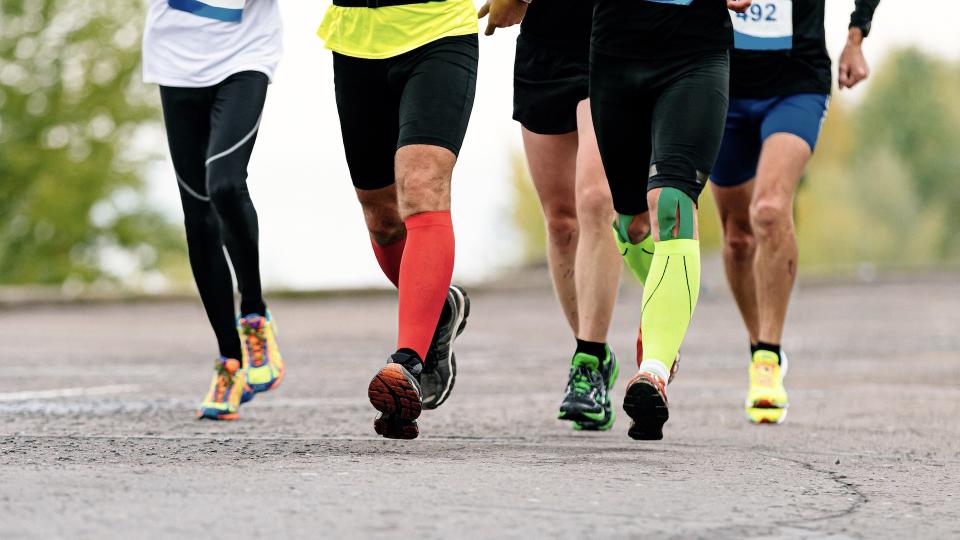Compression running socks – what do they do?

There are many different types of running socks to choose from from and one sock the does seem to be on the rise is the compression sock. You’ll normally spot runners wearing compression socks because they will be pulled right up to their knees.
The claimed benefit of compression socks is that they aid and support muscle use and decrease fatigue. We take a closer look at what compression socks might do – and the supposed benefits.
Why do the legs need compression?
Compression stockings, or socks, were originally developed for the treatment of deep-vein thrombosis. In most normal cases, your muscles do the work of moving blood through your veins. The body is clever and as your muscles contract, they put pressure on the surrounding veins, which squeezes the blood back towards your heart (veins have valves that prevent blood moving the wrong way).
However, some people suffer with poor circulation in their lower legs. This can happen due to a heart problem, or because of varicose veins. If you sit for a long time such as on a long flight, muscle compression is reduced and so blood and fluid can pool in the lower legs. For some people this can lead to swollen ankles, or even dangerous blood clots.
Compression socks are sometimes recommended for travelling, and for people who spend a lot of time sitting still. They are commonly used in hospital for patients who are unable to leave their bed, too.

Why runners might wear compression socks?
Compression socks have moved from the medical arena to the running world in more recent years. The theory of compression socks for runners is that they compress the blood vessels in your lower leg so that the blood and fluid can't pool there and therefore they can aid circulation. It’s also believed the socks can alleviate DOMs, or delayed-onset muscle soreness.
Another claim made for compression road and trail running socks is that they reduce swelling in the muscles, especially as they become tired from running longer distances, which means people can run further. Compression socks are also said to reduce the incidence of muscles cramps. Indeed, there's a range of claims for all types of compression clothing.
Compression running socks: what do the scientists report?
The studies on the usefulness of compression socks for runners have been very mixed and not conclusive.
The positive results include one study in 2009 that concluded "compression stockings are effective for enhancing performance during submaximal and maximal running exercise”.
In another research project, it was found that “wearing graduated compression socks provides a positive effect on proprioceptive control of the ankle joint [but] only after 21km [of running] and may therefore reduce the possibility of injury associated with proprioceptive ability diminishing over time during exercise".
On the other hand, a study published in 2014 found that the benefits might be more in the recovery phase than when doing exercise. It reported that “the findings suggest that CS (compression stockings) may not improve running performance, but could lend credence to certain manufacturers' claims of improved recovery through lower BLa [blood lactate concentration] values after exercise”.
Another study dismisses any positive affects of the socks for marathon runners. It concluded: “The use of compression stockings did not improve running pace and did not prevent exercise-induced muscle damage during the marathon. Wearing compression stockings during long-distance running events is an ineffective strategy to avoid the deleterious effects of muscle damage on running performance.”
For many runners it’s the wealth of anecdotal “evidence” that persuades them to wear compression socks. It’s likely, we all know of people who believe there are major benefits of compression socks.
If you suffer with calf fatigue or cramps, or you are keen to try to help your calf muscles to recover after exercise, it could be that compression socks are worth a try.

How to choose running compression socks
There is a wide choice of compression socks for runners. Here is a guide to what to look for.
You want the socks to cover the length of your calves but not to be so high that they bunch at the knee, or irritate the back of the knee joint.
Graduated compression is a good idea. This means the socks are tighter around the ankle and gradually loosen as they rise to the knee.
Look for compression ratings. For example, a rating of 20-30mm/Hg should provide moderate range compression.
There are compression socks for runners in different weights of fabric. Choose the right one to suit the heat and conditions.

Check sizing according to the width of your calves. Most compression socks will come in a wide range of fits.
Check the washing instructions because most socks can’t be tumble dried.
It’s not easy to pull on compression socks. They are meant to be very snug fitting.
If you don’t get on with compression socks, you could try compression sleeves, which are the same but without the sock foot.
It's often the case with running kit, such as compression socks, that you need to try it for yourself to see if it work or suits you.
The best trail running shoes: our top recommendations for technical terrain
